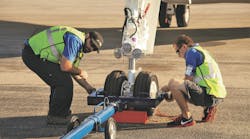The rate of employee turnover within ground handling operations varies widely, depending on several factors, including regional location and salary.
While the annual percentage of turnover for ground service operations can range from less than 5 percent to more than 90 percent, the fact remains that employees entering and exiting the job market have a tremendous impact on the ground handling world.
This issue was investigated by a panel of industry veterans during the IATA Ground Handling Conference (IGHC) in Bangkok, Thailand, this past spring.
Jon Conway, director general of the Airport Services Association (ASA), moderated the panel. He noted the industry employs approximately 1 million people, globally, with a handful of major ground handling organizations accounting for a couple hundred thousand.
When a person leaves an operation, that employee must be replaced. Of course, the new employee must be recruited and then properly trained. So when turnover is frequent, the associated costs increase exponentially. Additionally, with training resetting with each new employee, safety becomes an issue as well.
“So we have an issue, potentially, some quite serious issues in certain parts of the world,” Conway says. “I think we’d all agree the potential impact on safety, training and just experience is becoming a challenge to manage.”
The Foundation for Turnover
The panel of speakers at the IGHC attempted to identify the main culprits associated with employee turnover within the ground handling industry.
Ingrid Braeuninger, VP of sales and business development at Airport Terminal Services (ATS) pointed to environmental reasons such as economic factors, and the way businesses embrace and develop talent.
“I think what any company would focus on in times like this, is how do you differentiate yourself and become an employer of choice,” she says.
Braeuninger noted that due to economic factors, the market of employees has been constricted, and often times several industries are competing for the same people to fill open positions.
“There’s a lot of other companies and industries that aren’t as exciting as the aviation workforce. So I think we have something to differentiate from other industries that are looking for that entry- and mid-level employee,” she adds.
Mark Edwards, CEO at dnata Singapore, added there is not a singular item creating staff turnover issues.
He noted his operation faces government restrictions that penalize employment of foreign workforces, as an example. That, in turn, limits the pool of possible employees.
Furthermore, the success of Singapore’s education system depletes the number of available candidates as well, as new members of the workforce are seeking to apply their training in other fields.
Even when young employees do pursue ground handling, Edwards noted those workers are likely to move on quickly if they do not like the work.
“We’ve got a very age-related issue,” Edwards says, adding dnata attempts to label the job appropriately, so that by the time someone accepts a position, they are aware of all requirements.
What it boils down to is identifying the right person for the type of work – someone who is capable of handling second or third shift and working in varying weather conditions.
“There’s nothing particularly appealing, when you’re young, to take a job that’s not the best paid; that you get up at 2 a.m. in the morning to get ready to come to work for a 4 o’clock shift to be faced by seas of people, most of them not very happy because they don’t want to be there at 4 o’clock in the morning either,” Paul Craig, managing director of Aviance Ghana agrees. “I think that’s the big question. How do you get over that?”
The panel members noted that while turnover can be frequent, if a ground handling agent gets through the probation period, employee retention figures drastically improve.
Interestingly, frequent turnover isn’t always the problem. For example, Craig explained Africa’s unemployment rate has prompted people with jobs to hold on to their positions as long as possible.
“For every job you want to fill, you could actually get a thousand people fighting for it,” he says. “Our problem is that people don’t move at all. They take the job, and they stay.
“What you do face is an aging workforce, who no longer work at the same rate as they used to work in their younger years.”
Solutions to be Sought
Although some factors are out of an employer’s control, the panel participants agreed there are steps that can be taken to improve the employment landscape.
Braeuninger of ATS said ground handlers sell to the airlines and therefor drive wages, but she emphasized a company must find a balance between setting a price-range and attracting quality people. She noted it is important to think beyond increasing wages, which led her company to change its recuriting process.
She added it’s important to show potential employees everything that is required of them – both the good and the bad, even though that might reduce the number of total candidates.
“We don’t want to waste money training and developing someone who’s going to be gone in 30 to 60 days,” she says.
What’s more, training someone who will immediately leave is a potential safety threat in addition to the wasted money and resources.
“What we need to do is widen the funnel, so to speak, the pipeline of potential recruits, and continue to scour new areas and new channels for bringing in employees,” Braeuninger says. “So yes, we absolutely want to show them, ‘this is what the real job is about – and it’s quite exciting if that’s what you’re cutout for.’”
“I think one of the problems we face is the 24-hour operation,” dnata’s Edwards adds. “Fundamentally, I’ve found over the years that some people are suited to shift work and some just aren’t.
“It does take a particular person.”
With so many ground services outsourced, the industry needs to raise awareness about ground handling companies, too. Many people in North America believe airlines exclusively provide ground handling services, so they may be seeking employment in the wrong places.
Once a person is hired and put into position, it also may be worthwhile to speak with that employee regularly to ensure they are comfortable in their position. Employers can treat these “retention surveys” in a similar fashion as exit interviews that are conducted when someone resigns.
A retention survey can gather key information. Beyond wage, an employee may be unhappy with the work environment, a boss or co-worker or several other factors.
“We are definitely engaging more with our staff on a regular basis,” Edwards says, adding his company has sought advice for working with a younger generation of employees. “So far, there has been some very small improvement in retention amongst that group of people.”
Though it may be easier said than done, it is important for ground handling companies not to lose sight of the bigger picture. While it is vital to do what’s right for the employees, the best decisions must be made for the company as a whole.
Like many other businesses, ground handling companies are tasked with making themselves an attractive employer, being efficient and thorough with training and continuing to develop and retain people. However, accomplishing these feats is not a simple undertaking. Finding the solution to employee turnover on the ramp requires a holistic view of an operation.





